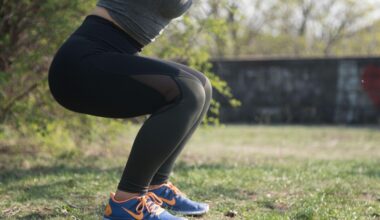Using Technology to Monitor Blue Light Exposure and Sleep
In today’s digital age, technology has permeated every aspect of our lives, including our sleep patterns. We often find ourselves glued to screens late into the night, exposed to blue light, which can disrupt our natural sleep cycles. Several studies highlight the correlation between blue light exposure and the suppression of melatonin, the hormone that regulates sleep. As a result, poor sleep quality becomes a significant concern for many individuals. Thankfully, innovative tech solutions exist to help monitor and mitigate blue light exposure. Wearable devices like smartwatches and fitness trackers often feature sensors that track sleep patterns and assess light exposure. These devices provide insightful data that can guide people toward healthier sleep habits. Furthermore, smartphone applications are also available to inform users about their exposure levels in real-time. By using such apps, individuals can adjust their screen usage effectively, minimizing blue light exposure before bedtime. Ultimately, the combination of technology and awareness can significantly improve sleep quality and overall health.
The Impact of Blue Light on Sleep
Blue light, primarily emitted by digital screens, significantly impacts our sleep by affecting circadian rhythms. When we expose our eyes to blue light during the evening, it can confuse our body into thinking it’s still daytime. This confusion leads to difficulty falling asleep and a noticeable decline in sleep quality. According to various research findings, the artificial light emitted from screens can reduce melatonin production, thus delaying the sleep onset. This phenomenon is particularly troubling for those who frequently use their devices before bedtime. To combat this, experts recommend implementing a digital curfew, which means avoiding screens at least an hour before sleep. By doing so, individuals can allow their bodies to naturally prepare for rest. Additionally, many devices now feature blue light filters or night mode settings that reduce the amount of blue light emitted during nighttime usage. Programs and applications designed to adjust display brightness according to the time of day can also be beneficial. Understanding these factors can empower users to take control of their sleep health and overall well-being.
Technological Solutions for Sleep Monitoring
Technology offers various solutions for effectively monitoring blue light exposure and enhancing sleep quality. Wearable devices, such as fitness trackers, provide users with comprehensive insights related to both sleep patterns and light exposure levels. Most of these wearables analyze heart rate variability, movements during sleep, and even the duration of different sleep stages. By understanding these metrics, users can evaluate their sleep quality and make adjustments accordingly. Furthermore, several smartphone applications monitor screen time, providing users with detailed reports on how much blue light exposure they received during the day. These apps help promote healthier technology habits by encouraging users to reduce screen time when necessary. Some apps also feature reminders that alert users when it’s time to step away from their devices. Additionally, integrating smart home technology can enhance the sleep environment. For example, smart lights can automatically dim or switch to warmer tones in the evening, reducing the exposure to harmful blue light as users prepare for rest. Utilizing these technological advancements can help mitigate the adverse effects of blue light and promote better sleep.
Another effective method to minimize blue light exposure is the use of blue light blocking glasses. These special lenses filter out blue wavelengths emitted by screens, significantly reducing their impact on sleep quality. Wearing these glasses, especially during evening hours, can help individuals transition into a more restful state more easily. The glasses are particularly beneficial for those who have no choice but to use their devices late at night. Additionally, many people adopt habits that contribute to better sleep hygiene. Establishing a regular sleep schedule is crucial; going to bed and waking up at the same time every day can improve overall sleep quality. Creating a bedtime routine that is relaxing can also prepare the body for sleep. Activities such as reading a book, meditating, or practicing gentle yoga can help ease the mind and body. Drinking herbal tea can also be a comforting pre-sleep ritual. In conclusion, technology and mindfulness can work hand in hand to help improve sleep health, making it easier to manage blue light exposure effectively.
Integrating Screen Time Management
As part of sleep improvement strategies, integrating effective screen time management is essential. To reduce blue light exposure, individuals should be conscious of their daily screen usage. Implementing tools and techniques that encourage healthier usage patterns can be beneficial. For instance, intentionally designating specific times for device usage can create boundaries around screen time. Additionally, many smartphones and tablets offer built-in screen time tracking features. Users can monitor their digital engagement, making it easier to identify excessive usage. Setting limits on apps or utilizing ‘do not disturb’ functions during the evening can foster a peaceful environment conducive to sleep. Conducting digital detox days or weekends can also greatly enhance overall well-being. Taking regular breaks from screens, especially in the hours leading to bedtime, can have a positive impact on sleep quality. Families can work together to establish tech-free zones or times, encouraging social interaction and relaxation without screens. By actively managing screen time and creating healthier tech habits, individuals pave the way for improved sleep and overall wellness.
Establishing healthy sleep practices can lead to lasting improvements in sleep quality and recovery. One of the primary goals should be to create a conducive sleep environment free from intrusive blue light. This can be achieved by using blackout curtains, eye masks, or utilizing ambient lighting that favors warmth over harsh, cold tones. Additionally, maintaining a cooler room temperature can enhance sleep comfort, as many individuals find it easier to sleep in a cooler environment. Furthermore, limiting caffeine intake during the afternoon and evening can also support better sleep quality. Caffeine is a stimulant that can prolong wakefulness, making it difficult to drift off at night. Practicing mindfulness techniques, such as deep breathing and visualization, can also foster relaxation. Incorporating regular physical activity into one’s daily routine contributes to physical well-being, which indirectly affects sleep quality. However, it’s essential to avoid strenuous workouts right before bedtime. By integrating these habits into daily life, individuals can effectively reduce the disruptions caused by blue light and promote a rejuvenating sleep experience.
Conclusions and Future Directions
In conclusion, managing blue light exposure through technology plays a vital role in enhancing sleep quality. As our reliance on devices continues to grow, it becomes increasingly important to understand their potential effects on sleep. Embracing various technological solutions allows individuals to track their exposure effectively and make informed decisions regarding their digital habits. With ongoing advancements in technology, future tools may offer even greater assistance in optimizing sleep health. Innovations such as advanced sleep tracking and smart home integration will likely become more prevalent, empowering users to create personalized sleep environments. Additionally, further research into light exposure’s effects on health will provide valuable insights into best practices for sleep hygiene. As awareness of blue light’s impact grows, more individuals are likely to embrace healthier habits that promote restful nights. Moreover, fostering a culture that prioritizes well-being and recovery in our digital world is critical. By recognizing the connection between technology use and sleep health, society can create environments conducive to rejuvenating sleep experiences.
By recognizing the importance of reducing blue light exposure in the quest for better sleep, individuals can take proactive steps toward an improved quality of life. As sleep patterns continue to be disrupted globally, employing technology in a mindful manner can lead to sustainable change. Prioritizing sleep across all demographics is essential for overall health and wellness. Ultimately, the choices we make related to technology use shape our well-being. Engaging in self-care practices that pave the way for healthy sleep can transform not only individual lives but also communities. As we move forward, balancing technology use with sleep health will be a hallmark of a mindful approach to living in the 21st century. With the right tools and knowledge, each individual can foster a conducive sleep environment, effectively reducing blue light impacts, leading to better recovery and overall health. The future of sleep health looks promising as we continue to harness technology intelligently. Cherishing sleep as a vital component of health will usher in a positive shift in how we view sleep in our technology-driven lives.


